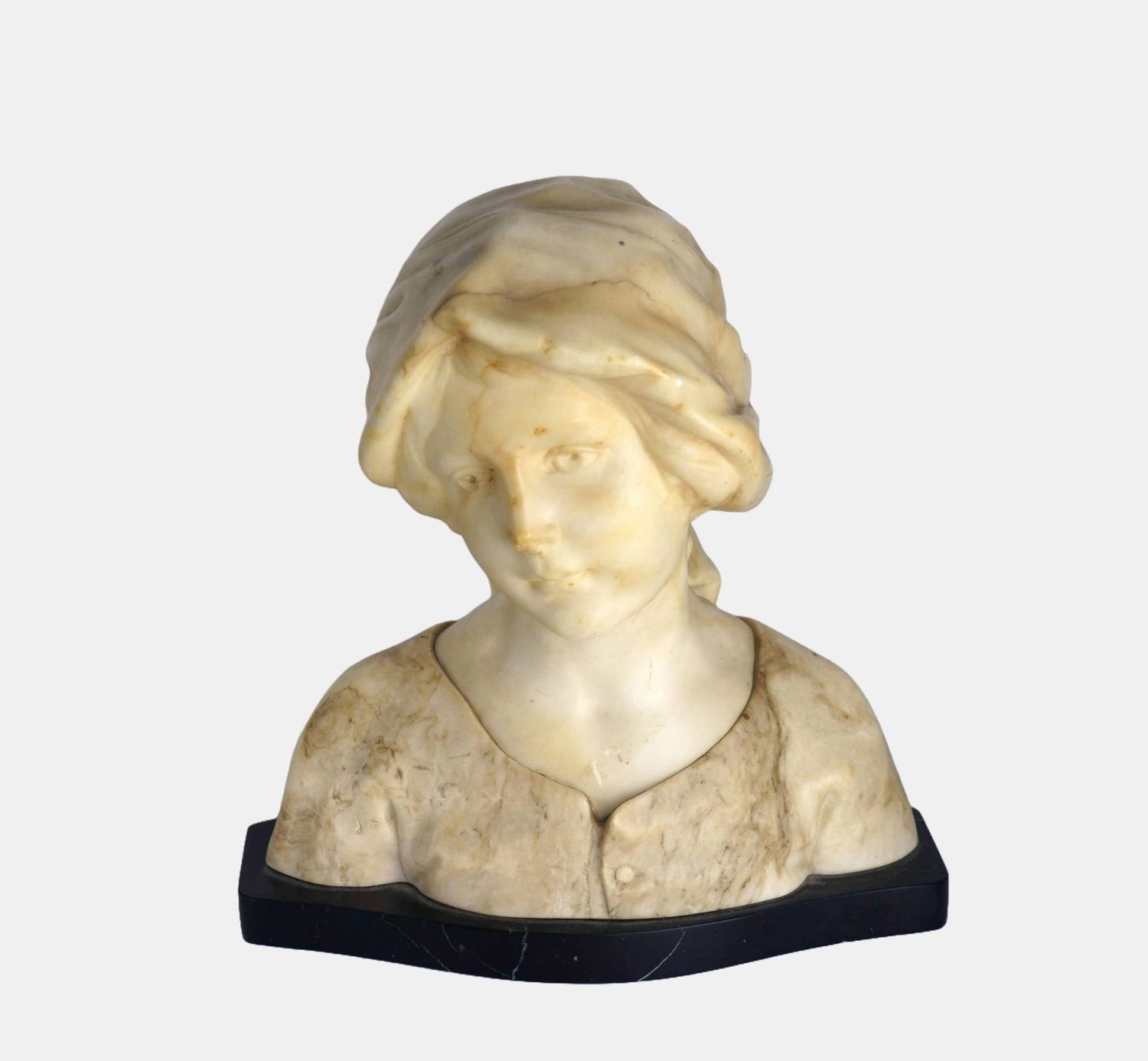Kochendörfer, Fritz (1871-1942), Bust of a young woman with headscarf, around 1910
Fritz Kochendörfer(1871 Mannheim - 1942 Osterode am Harz), Bust of a young woman with headscarf , c. 1910. Two-tone alabaster on a curved black marble plinth, 24 cm (height) x 22 cm (width) x 14 cm (depth), 4.9 kg, signed “Kochendörfer fec[it].” and numbered 6 7 90 / II / 376 on the reverse, metal plaque “Kochendörfer. Original Hofkunstanstalt. Medal for Art Munich 1891.”
- Tip of the nose bumped and very isolated bumped areas, two small stains on the headscarf, otherwise in good condition.
- Farewell to Childhood -
Kochendörfer, who had spent time as a sculptor in Florence, created a work based on the marble portrait busts of the early Florentine Renaissance. Instead of the self-confident gaze out into the world opened up by the Renaissance, as in Desiderio da Settignano's portrait of the young Marietta Strozzi from around 1460, Kochendörfer gives the girl an introverted expression that exudes the melancholy of the fin de siècle. Her head is inclined downward and her gaze is directed inward. However, her contemplation is not an oppressive melancholy, but at the same time exudes the lightheartedness of childlike innocence. But the girl is no longer a child, she has become a young woman, so the contemplation is a wistful farewell to her own childhood.
The transformation from a girl to a young woman, who covers her hair with a headscarf, adds an erotic component to the portrait, which is enhanced by the sensual appearance of her body. The garment, of a different color, is darker in tone and has a grain running through it, which makes her skin appear even more delicate and pure. The face, with the straight bridge of the nose, the large eyes, and the finely curved mouth, gives the young woman an aura of untouchable ideality. Yet the face does not appear frozen, but extremely lively, not least because of the addition of yellow tones.
The viewer is drawn to the young woman's beauty and at the same time encouraged to share her thoughts. This creates a sense of connection, even though the sitter is completely absorbed in herself.
About the artist
Fritz Kochendörfer was the son of a Sonneberg doll manufacturer. This meant that he was literally born with an affinity for the sculptural figure. Accordingly, he studied sculpture at the Munich Art Academy, but was unable to complete his studies due to lack of funds. After stays in Rome and Florence, where he devoted himself to marble sculpting, he began working for Kunstanstalt Schumacher & Co. in Osterode am Harz in 1896.
Founded in 1887 by Gottfried Schumacher, the company experimented with new materials to imitate marble. The gypsum-based "Chromoplasta" initially invented did not have the desired material properties, but formed the basis for the development of "Marmalith", which could be used to cast marble-like works. However, this gypsum-based material was also sensitive to water, so Schumacher developed a casting process using ground white marble to meet customer demand for washable surfaces. With the growing prosperity of the middle class, the demand for real marble sculptures increased after 1900, leading to the establishment of a sculpture factory.
Fritz Kochendörfer learned the techniques of stone casting at the Schumacher company before opening his own workshop in 1899, also in Osterode. He continued to experiment with improving the casting process and developed a chromium plating technique that made it possible to give the artificial marble a variety of colors and veins. He was so successful in producing his cast alabaster sculptures, which looked like real marble, that at the height of his career he employed over 100 people in his workshops. In 1913, the Hofkunstanstalt was renamed the Kunstgewerbliche Anstalt. It was closed in 1927.

